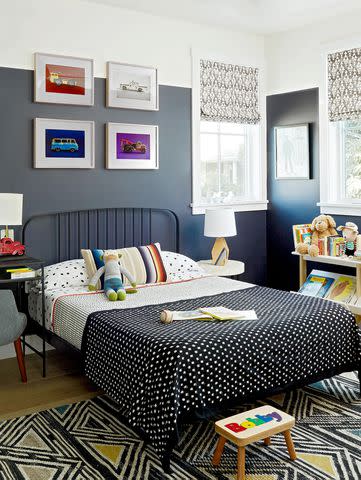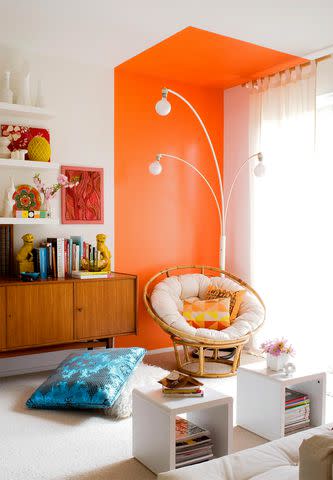Two-Tone Walls Are a Low-Lift, Big-Impact Paint Option

This bold paint treatment might just be the new accent wall—and at the very least, it’ll bring fresh color to your space.
For years, accent walls reigned as the statement-making paint treatment of choice. The single painted accent wall gained popularity as an easy way to deliver a splash of color without the commitment of a whole-room paint job. But now, we're seeing designers and homeowners embracing bold paint colors in more significant ways, and two-tone bedroom walls, living room walls, and two-tone walls in other rooms are one of our favorite wall treatment ideas.
Painting walls with two colors creates instant contrast and architectural interest with just a few paint strokes. "The two-toned wall provides a clean, modern way to add dimension and the illusion of architectural details to a space," says Nivara Xaykao, a former color specialist at Benjamin Moore. "Plus, it's also a lot easier to paint a wall than to install trim."

Whether you want to make your space feel larger or deliver an unexpected dose of color, this paint technique is easy to customize to accomplish the look you want. Sue Wadden, director of color marketing at Sherwin-Williams, suggests varying the height of the paint line according to your liking: "I prefer to switch hues in either the lower third of the wall or up top towards the ceiling," she says. "It doesn't have to be exact halves!"
Tip
Painting your wall two different colors can create the illusion of space if you use a lighter color on the top half: It draws the eye up and makes the ceiling appear higher than it actually is.
To achieve the two-tone look, determine the height of your paint line, measuring from the ceiling down for a horizontal break. Once you've finalized your design, tape it off using painters tape and a level, and start painting!
Two-Tone Wall Ideas
Looking for two-tone wall inspiration? Here are six tips and ideas to get you started.
Related: How to Use Color Swatches to Pick Paint Colors

Line It Up
Can’t decide where to start your paint line? Use an existing feature in the room—such as a door frame, chair rail, or fireplace mantel—as a guide. Align the block of color with your horizontal element of choice to achieve a crisp, orderly look. If you're using your windows the guide, start your paint line at least 12 inches above or below it—rather than directly in line with it.

Bring Color to the Ceiling
Another idea on where to break between colors: Paint one shade up to picture molding height, usually about 12-20 inches below the ceiling. For extra impact, Wadden suggests painting the ceiling the same color as the top hue to create the feeling of a more expansive space.
Combine Colors
When it comes to this paint trend, we say the bolder, the better. Pick two of your favorite daring shades for a high-energy, color-on-color effect. To keep the two-tone treatment cohesive, stick to one paint sheen for both colors.
Related: Types of Paint and Paint Finishes to Know Before Your Next Project
Try Tone-on-Tone
Or try a monochromatic effect and choose contrasting tones of the same color—for example light blue and dark blue. In this case, varying the sheen between the two hues (one matte and one glossy) adds texture that further defines the two tones of blue on the wall.
Related: 6 Pro Secrets for Getting a Monochromatic Room Right

Highlight a Specific Feature
Use the two-tone technique to emphasize or add depth to a certain area of the room—without adding any fancy millwork or other architectural details. “A two-tone wall can be an effective trick to either make your space feel larger or more intimate, so experiment with where you put the blocks of color to achieve your desired effect,” Xaykao says. Painting one section of the room in a different hue, for example, can turn an ordinary corner into a cozy nook.
Related: The Perfect Cozy Colors Palette for a Warm, Inviting Home

Temper an Intense Shade
If a floor-to-ceiling bold color on all four walls makes you nervous, two-tone walls may be your answer. "My favorite application is pairing bright colors with a light neutral or white," Wadden says. Limiting the vivid hue to one half of the wall prevents it from overwhelming the room.
Related: 23 Tips for Choosing the Right Paint Colors for Your Home
Get Creative
Two-tone walls are even more eye-catching when you add some personality to the treatment. One idea: Carry the color block across secondhand artwork for a touch of humor. Make thrifted or garage-sale art pop by skimming the bottom of the piece with the lower wall color and matching up the paint lines.
Whether you go bold with a vibrant color combination or meet in the middle with a muted pastel treatment, these two-tone wall paint ideas are guaranteed to make a modern impact.
Frequently Asked Questions
What are some popular two-tone wall color examples?
Popular wall paint color combinations include high contrast pairings like black and white; coastal colors like blue and beige; dessert hues like cactus green and terracotta; and even tone-on-tone combos like taupe and chocolate brown or pale gray and charcoal.
Should two-tone walls always be divided on the horizontal?
It all depends on what effect you’re trying to achieve. Dividing the wall along the horizontal can create an illusion of more space if the top half is lighter. Conversely, a dark top half can feel cozy and enveloping. If you’re looking to create zones in an open floor plan, dividing the wall on the vertical can help define different areas.
Can a two-tone wall paint treatment save me money?
In some cases, yes! If you keep your existing paint color on the wall and just buy enough paint for the second color, then you don't need to repaint the entire wall. Also, if there's an architectural feature you don't like—the look of a radiator or fireplace mantel, for example—you can paint the lower half of your wall a dark color to camouflage it without having to replace it or renovate.
For more Better Homes & Gardens news, make sure to sign up for our newsletter!
Read the original article on Better Homes & Gardens.